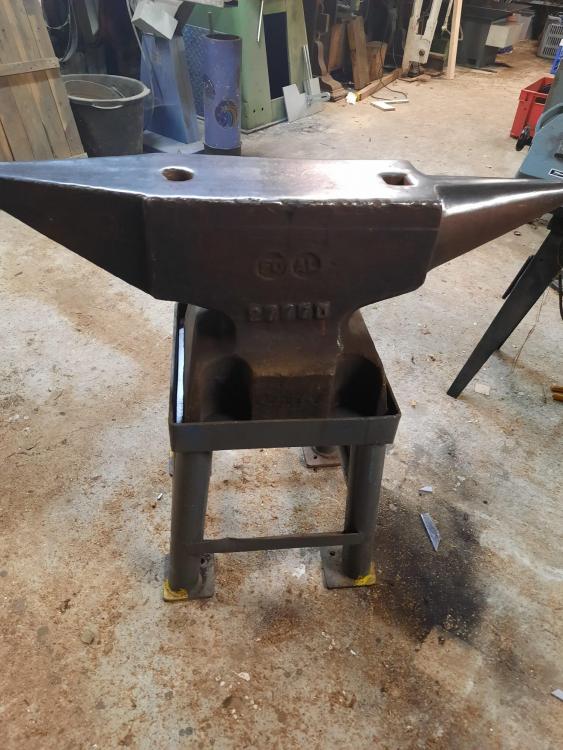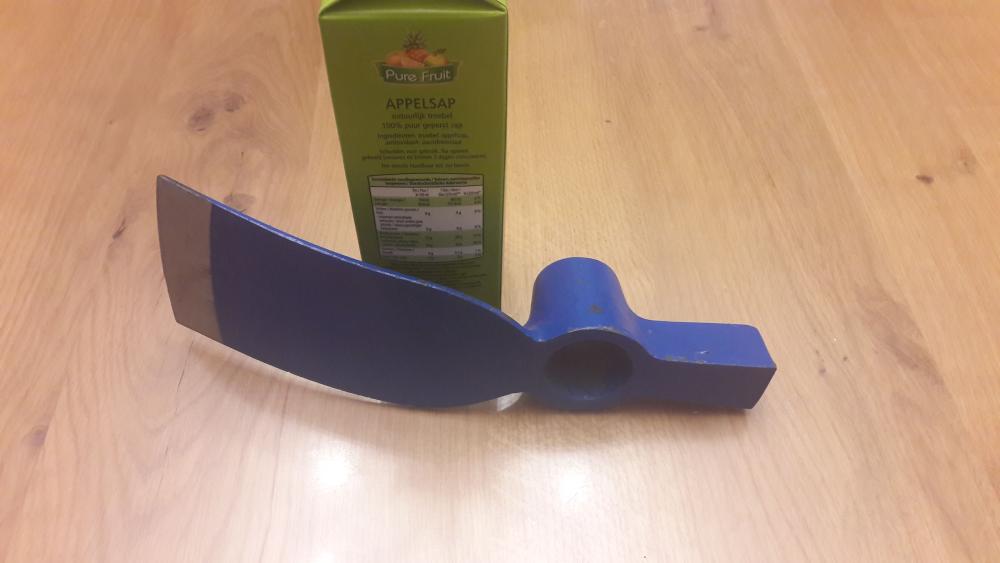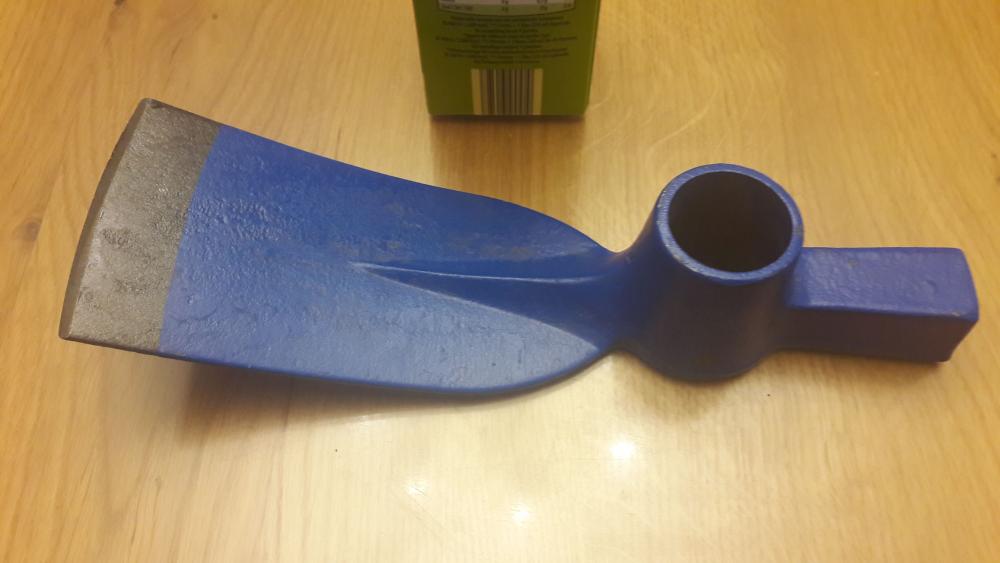
BartW
Members-
Posts
281 -
Joined
-
Last visited
Content Type
Profiles
Forums
Articles
Gallery
Downloads
Events
Everything posted by BartW
-
First picture in this thread show the really nice sloping curve. The horn usually isn't symmetrical; but the rounding very gradually slopes towards the flat; so you have essentially a wide choice of edge-radii to choose from when forging. In practice; this means french anvils are less susceptible to farriers damaging the anvils drawing out the toes of horseshoes.
-
Having used both, I prefer the German style anvils. Sometimes it's handy to be able to rotate a hardy tool and still make it fit. In the French setup; they cannot be rotated. Most of my home-made hardy tools however fit so tight; and the hardy hole isn't perfectly square; they cannot be rotated anyways. But that's more my fault. If i'd take a couple more heats and made it fit while rotating ... Also the french style anvil has a really cool long curve on one side; which is very handy drawing out, even if the anvil is mounted too low or too high.
-
The markings are fairly simple and self-explanatory: Maker: "Joris et Dambrun" (company) location: "a Paris" (in or near Paris) Serial nr: "N 30772" Weight: "P 112 KG) (Poids 112 Kilograms) I wouldn't worry about the "crack" in the bottom. These were cast up-side-down, so it could be a "molten-steel"-fold and not really a crack. Once they cooled enough, the mold was broken open , maybe some refinements were made like the hardy hole ( so a bunch of burly dudes with 20 pounds sledges) .. then it was rolled outside and put under a water tap to harden, and after a specific amount of water the residual heat in the body tempered the anvil. They would return the day after, check the anvil, and start cleanup on big milling machines. Fascinating proces to observe (I've seen it once in Belgium) This method does result in fairly hard tips, this had advantages and disadvantages. The hardy hole is also specific sided; and you need to forge tooling for it, but first make a specific punch to push out stuck tools ( been there, got the T-shirt) .
-
In France, in the city of Saint-Denis (Paris), there was a steel foundry called "Joris & Dambrun" ... like 50 years ago, they went bust during WO2. It helps if you can search in french (I speak french & dutch, I'm from Belgium). They were known for producing lathes; apparantly they also made anvils. As for quality & construction; in this part of the world the classic wrought iron body with a steel face were not very common; they were mostly cast steel anvils in the past 150 years. Most anvil producers held rather high quality standards and rejected about half of the castings. Access to high quality steel is also no issue in this part of the world. However, as Frosty said, the anvil made it across the pond, and it could have been in a fire. To be tested I suppose.
-
There is an open-air museum-ish village close to here; and they have quite a few hundreds of years old houses. Including a forge But in the exposition, there a lot of threshing flails, probably because they look good. But as for the wood used; the shaft is usually light and flexible; so elderberry, hazel. The head is usually heavy and hard; and they are all Oak. As for crabapple; I actually haven't used that before. I know Apple tree makes lousy handles; while pear wood looks nice on knifehandles, stabilized, but isn't strong enough for handles.
-
Europe has much variations in climate actually. Nordic birch (slow growing birch due to the cold) is the same tree as the birch growing in my backyard. Nordic birch is a good handle material and quite hard and resistant. The birch growing in my backyard are soft like pine. Hickory doesn't grow terribly well over here; but Robinia (Robinia pseudoacacia) Is the most dense and resistant natural growing wood in western europe. Ash, Beech, chesnut, hazel, elderberry, buxus, afzelia, rhododenderhon, rozewood, magnolia ... I used them all for handles. typically I avoid most pine and oak (they "bleed" some kind of acid turning your hands black) variations. If it's soft enough for me to dent with my nail; I leave it alone too. Keep in mind that "how" you cut the handle and mount it is really important in longevity of the tool. I attached a drawing I found on the internet a loooooong time ago.
-
Hello All; I've got some information request concerning the vise below. The story: Worn screwbox; and broken handle bar and foot. I couldn't get the handle bar to weld correctly, it's some funky very large grain iron which makes welds go brittle. Then I found a truck kingpin thing to mount a spare tire; it is partially threaded M20 , not drilled all the way through. I cut that thing in half; the threaded section forms the screw-box; the non threaded half is secured to a threaded rod, and I machined a washer in front. Then added 2 nuts with the thread cut out to form the handle-bar holder; and a threaded rod with the threads cut off is the handle. To protect the threads I welded a pipe over it, and added a key to prevent the box from rotating. Then I manufactured a V-spring from a leafspring (this is WAY overkill). It clamps really slow (but pinches hard). It isn't ideal; trapezoid thread would have been better and faster. As such, I wouldn't recommend it as general usage vise; but a blacksmith bending, drifting and hammering vise; sure. As a base I welded it Very thick plates; and now I use it to clamp stuff and hammer; or a adjustable swage block to punch holes. Maybe somebody can get ideas from this fix; there are a few "hacks" in this one
-
Replacing screw/box with parts from a scissor jack
BartW replied to Justor JeiGallo's topic in Vises
I wouldnt weld it. Chance of brittleness is too high. Well... with my welding skills at least: D I had a similar problem once, and i fixed it with a m20 screw box, a piece of pipe to protect the threads and a key to build this: the bar was made from another piece of m20 wire Rod and 2 nuts . The box and front part and salvaged from a truck spare part mounting. -
I though about it for a while, and I have heard a lot of different theories. I usually aim for knucle-height; but I have others lower and higher depending on what work you are doing. Usually it's my back that notifies me after a couple heats it's too low for this task; or the bad hammer control and low power if it's too high for a task
-
Well it was more of a outdoor fair scenario dozens of years ago, with lots of people hammering on lotsa a things... I'm not sure a lot of "teaching" was happening. The reason I remember well is I was talking to one of the "smiths" and I tell him that those guys over there with sledgehammers look like an accident waiting to happen. He turns his head, open his mouth to say something and before he does; "pling", the top face cracks open. A half-moon shaped section of anvil face fell to the dirt floor. The dude goes "*curse-word* ... Sigh.... " and walks over there. Memorabel moment, and so much wrong going on in one picture...
-
Well; In beginner courses, I've seen a 100 pound vulcan destroyed using sledges & beginners. And I mean half moon cut-outs in the thin faceplate on both sides, so the plate on top is almost cut in half. So big hammers and vulcan's is a no-go if you can miss. However is it better than half the weight higher quality anvil? Yes long term; but single use .... I don't think so. Vulcan's aren't that bad, and they won't give you a headache from the high-pitch sound. They just have a thin faceplate. All my "work" anvils are way bigger (300, 430 and 700 pounds) and way higher quality (cast tool steel; HRC 60 ). These days I leave the beginners whale on the 430 pound skoda anvil; it has rounded edges and it eats sledgehammer faces If you are nervous hitting something; don't. steel shards flying around is always a bad idea. Get something in simple iron like a striking anvil, and don't bother with dings.
-
Hello; I live in Belgium, very close to Herstal; and I've been through the old (and new) gun workshop places. They have lot's of anvils, but all were flat. For making barrels they have huge swage blocks; and power hammer dies the size of anvils with different rounds in them. I've never seen an anvil with a halfround cut-out in the surface. All barrel making is done with power hammers making the huge blocks of twisted steel; making that round and then over to a lathe. I do have another theory... what if it was a cutout for anvil blocks; like a power hammer die fixture ? They were fairly common; and if that shape get's worn out; they may have ground it to a half-round ? Belgian anvils have very distinctive feet actually (wide and relatively flat); have a look at UAT anvils. To me this one seems more german like the S&H anvils.
-
Should I get a training anvil for blacksmithing?
BartW replied to SupaConducta's topic in Anvils, Swage Blocks, and Mandrels
A week ago, I found a young kids who wanted to get into blacksmithing. He had pretty much excactly the same question as you have. What to get to start, and do I need a real anvil (and what if I damage it.. ) ? I gave him this thing described here: I still have a couple bars of those left, and the ones I gave way to get people started have all been fairly popular. Some use them on the side; some use the flat face .... some use it as a swage block or a bolster plat once they upgrade to a real anvil. -
Hello; No, they were pretty much cast as you see them. The feet do have an odd shape with the 4 huge halfround holes; but I've seen stands for these anvils which came from the machine shop of a marine ship which used these holes to grab and secure the anvil. With a boat rolling in the waves, I don't think you'd want an anvil to come off it's stand Makes sense too, given they were Cast in the Czech region under Nazi occupation up untill the 1970'ies by the steel plant which made battleship parts & other large castings.
-
-
Hello; Coming from Belgium, I know the beginnings of Belgium and German anvils, but i know awfully little about Dutch anvils. I know they were a "thing" given the shipbuilding history; but I've never been confronted with one. Maybe Technicus Joey (youtube) knows something about this anvil ? Can you test the anvil ? IE, how hard is it, how is the ring/ rebound ? does it have a steel top plate and a softer body ? Is it one-piece steel ? VR really doesn't tell me anything, sorry.
-
Instead of welding a leg (I'd recommend frosty's method); as an alternative, you could make a matching "socket" which you mount on the floor, as such you can make a low socket and a high socket; depending on your needs ? The stump looks round; it should be possible with a lathe to make a matching socket with a snug fit.
-
German Church Window Anvil
BartW replied to Ridgeway Forge Studio's topic in Anvils, Swage Blocks, and Mandrels
Did you have a look at this thread : -
you didn't damage it at all. an anvil is just a tool. Historically absolutely fantastic work has been done on a block of iron we'd call a sledgehammer head. Your creativity and motivation is much more important than your anvil.
-
Hello All; I wasn't really looking for anvils, but for some reason, anvils tend to find me (odd enough). Yesterday some guy contacts me via my buddy from the railways-maintenance company, and asks if I'm still interested in an anvil. So I said "sure". Can't imagine a blacksmith or bladesmith would answer something else. He says:" Well, we were cleaning this place; and we found a rusty old anvil, and we know you seem to like the previous one. So if you are interested, we'll set it aside; and tomorrow we'll discuss price and such." Sooooo I grab some pocket change and 3 crates of 24 x 33cl belgian beer, and head off. Now I'm back home with less beer and more anvil, and they are a happy crew ;-) Funny thing; both previous skoda's were excactly 154 kilo's; and had an upsetting block. This one is 195,5 kilo's (431 pounds says the calculator), and no upsetting block, but longer and wider, same height. one-piece cast tool steel, hardened. about half a mm sway, and some minor edge-damage (the wire-brushing I did makes the edge damage look worse than it really is). I'm nog sure what to do with the stand though .... it's solid enough, but I still kinda prefer tripods or tree-sections. Friendly greetings, thanks for watching. P.S. it's good to be back after a long absence.
-
I got one fairly similar, built in 1908 in Belgium in Herstal in the guns factory. I find the holes in the side with different radii usefull for making coal shovels and such. It behaves different from a solid cast tool steel anvil, but it's very pleasant to forge on. You can find a LOT info about it here :
-
From my testing into this subject; There are 3 parameters of an anvil base important: 1. mass of anvill base. 2. how rigid the anvil is secured. 3. The material of which the stand is made. Short answer: yes; an anvil base can have a large effect on the performance of al anvil. I have 2 identical anvils; modern solid one piece very hard tool steel. One is perfectly affixed to a wooden stump - zero motion; and the stump is affixed to the concrete floor. The other had the same kinda of stump; but was strapped down ... massive difference. Than I changed to a steel tripod; and again massive difference. my prefererence right now is either a hardwood stump glued to the floor and the anvil glued to the base so you have an immobile anvil. OR a steel tripod with filled legs and reinforcements. Most notably is the sound produced difference; I like my anvils as muted as possible.
-
Hello Everybody; I recently got a box of these (literally a couple dozen). I handled 3 (long handle; medium and short) and parked them in the garden shed; but how many does anyone need .... Goofing around I already made a warhammer from it, but this is more cutting parts off and grinding some. But it's good steel (I guess C50, as it hardens in water and it's somewhat the standard steel of the supplier), so I wonder; can you forge this thing into an axe ?
-
I've seen one just like it - even the blue paint - in a metal workshop near Amsterdam. It looks good; modern cast steel anvil; but I don't have more details than that.
-
or make angled thick washers to distribute the pressure. Now all pressure will be pointed upwards and attempt to shear / split the wood. Like a knife trying to cut a piece wood off. But this will hold an anvil down fairly effecient.
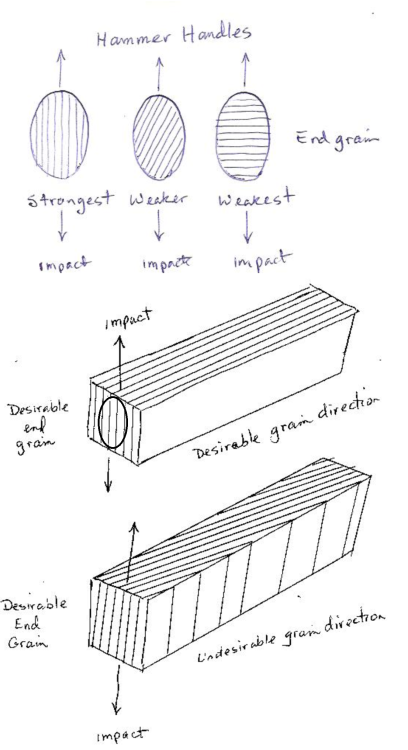
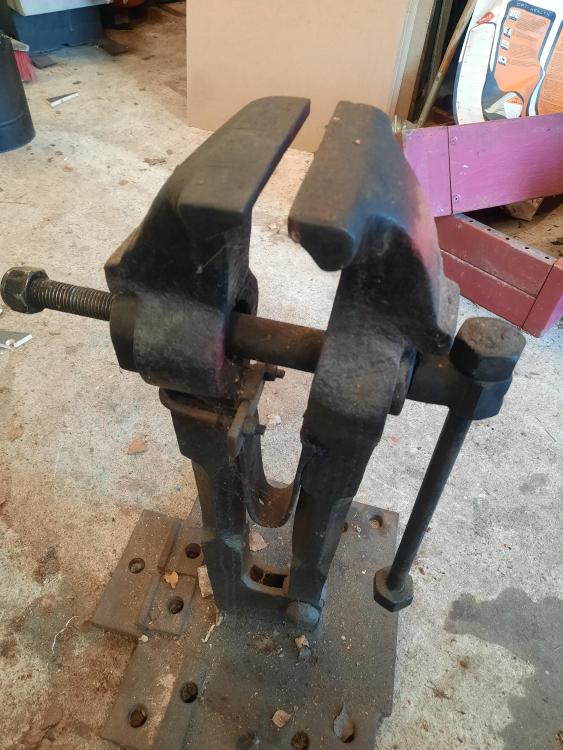
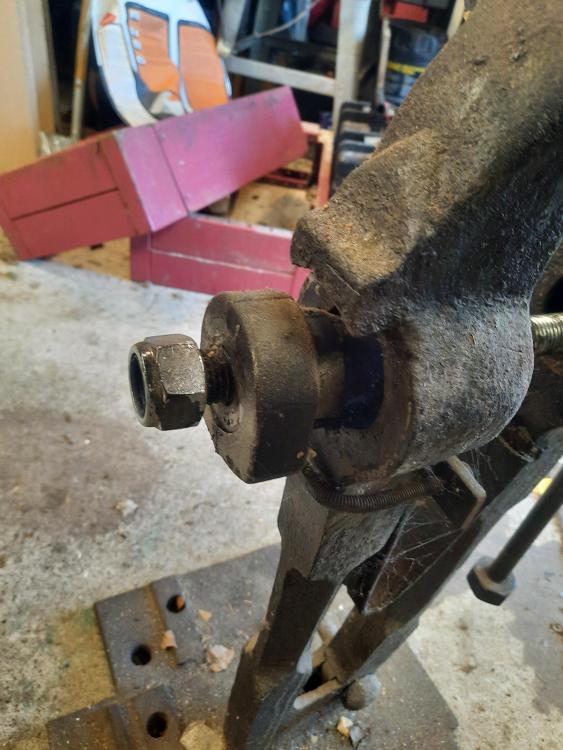
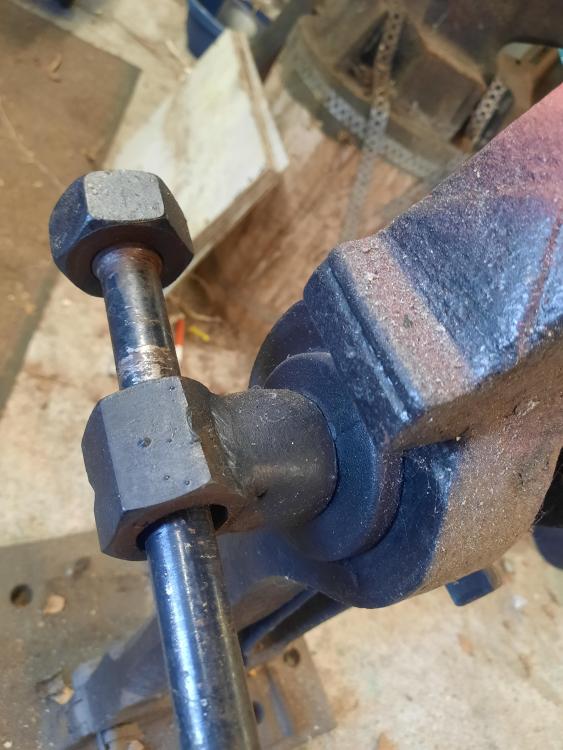
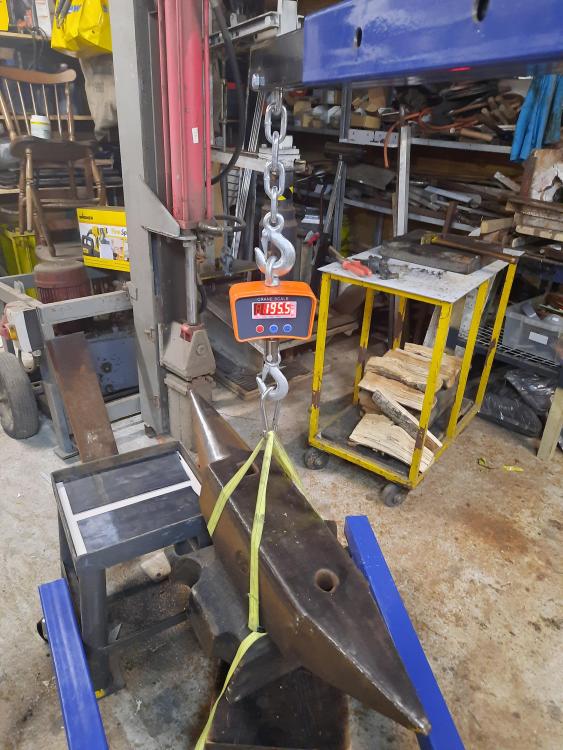
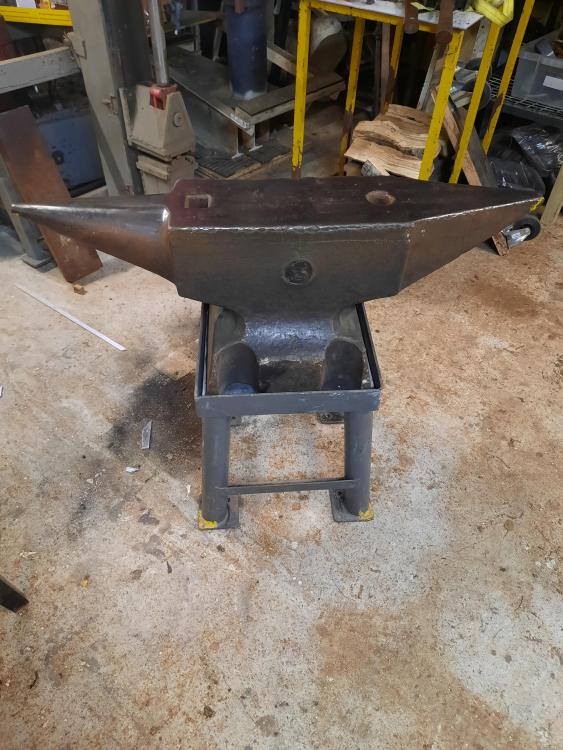
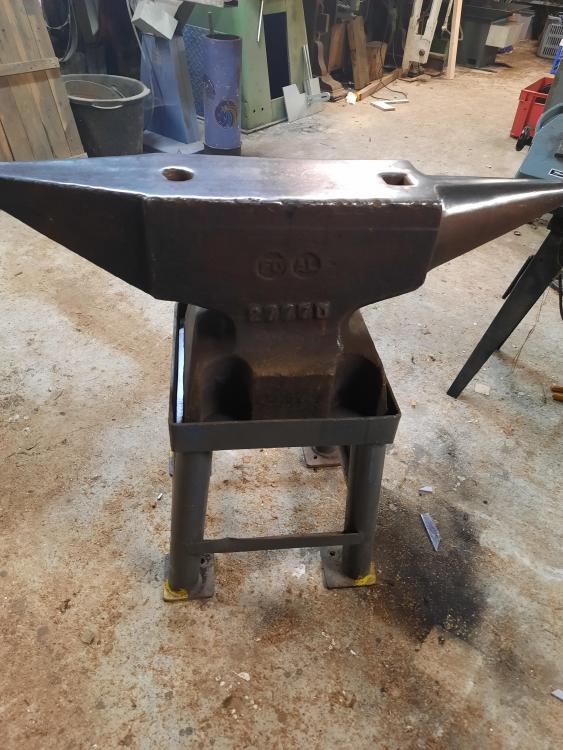
.thumb.jpeg.e6a81819a7e4cf3811ae503fcd4ee700.jpeg)
